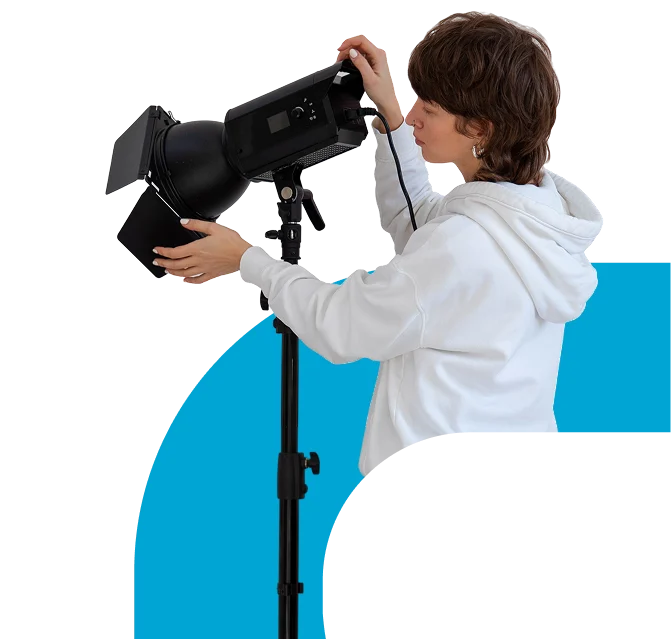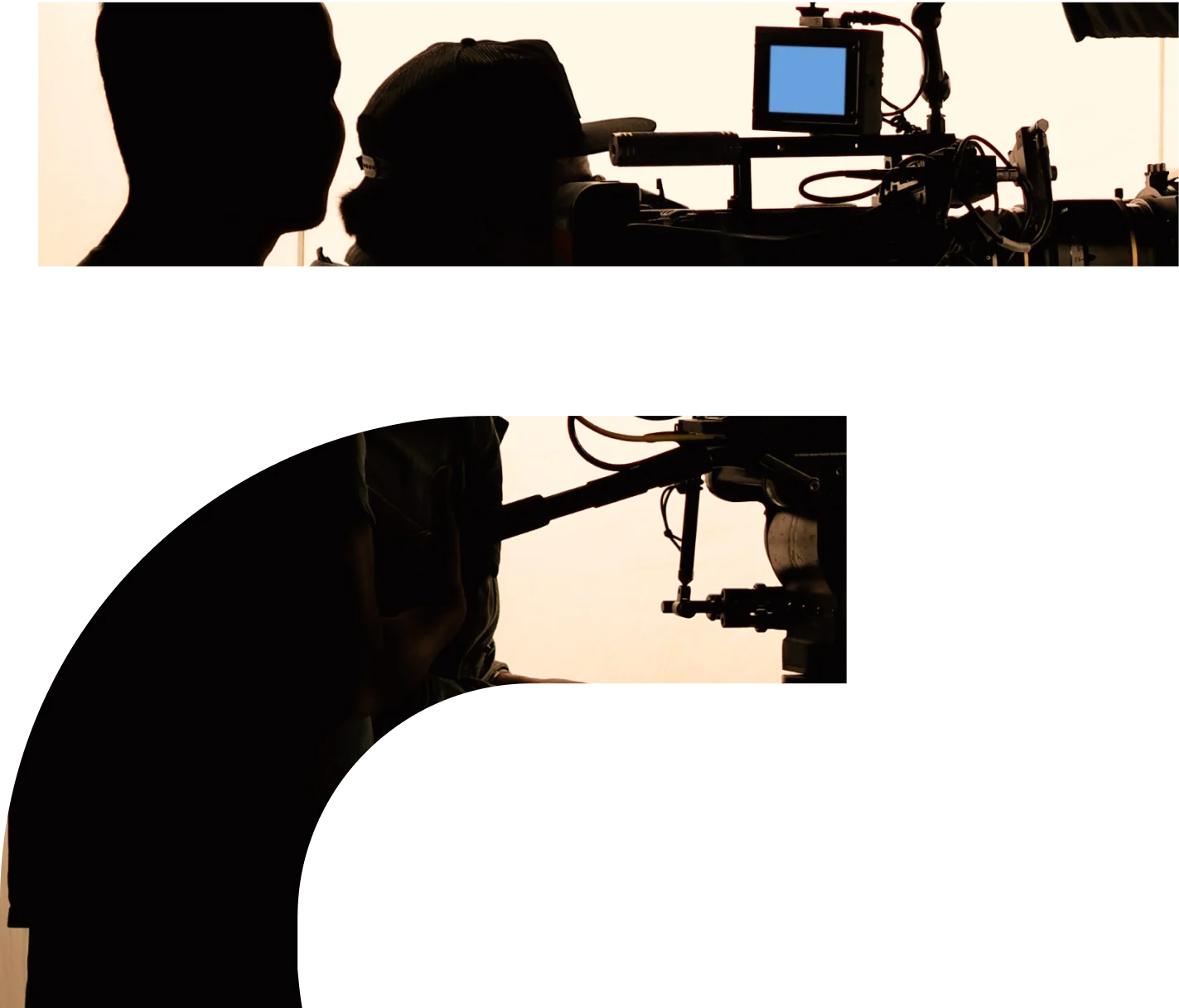Working closely with the director of photography, a gaffer is responsible for overseeing all aspects related to lighting within a movie or television production. Through the strategic deployment of various lighting instruments and leveraging their expertise in electrical systems, the gaffer strives to establish an environment that aligns with the desired mood and ambiance for each scene.
Using various types of lights and their knowledge of electricity, the gaffer makes sure everything is well-lit and looks fantastic on camera. The gaffer's team, the electricians or lighting crew, helps set up and control the lights. They handle things like placing lights in the right spots, adjusting their brightness, and ensuring the lighting equipment is safe.
The gaffer's job is crucial because good lighting can make a scene dramatic, romantic, or even scary, depending on the story's needs. You can think of the gaffer as the person who paints with light, helping to bring the director's vision to life on the screen. They use their knowledge of lighting techniques and equipment to make sure every shot looks just the way it's supposed to, helping to tell the story in the most visually compelling way.
They often work with grips, who are responsible for keeping the light in place, building scaffolding for specific lighting requirements, and other standards that might be needed.


In the film industry, a gaffer is responsible for managing the lighting department on a movie or television set. With a role that extends beyond simply operating lights, a gaffer collaborates closely with the director of photography to craft the visual atmosphere of each scene. Their role combines technical proficiency, creative collaboration, and leadership skills to shape the visual identity of a film or TV production through the effective use of lighting.
Gaffers oversee the entire lighting team, ensuring the implementation of the director's vision. They are involved in planning and executing lighting setups, selecting appropriate equipment, and strategically placing lights to achieve the desired aesthetic. The gaffer's expertise is crucial in manipulating light to convey emotions, enhance visual storytelling, and establish the tone of a production.
Additionally, gaffers are skilled in electrical systems and safety protocols, as they handle the complex task of managing power distribution for various lighting instruments. They work closely with the electricians or lighting crew, delegating responsibilities and supervising the installation and operation of lights.
A gaffer must have top-notch problem-solving skills, be able to adapt to diverse shooting conditions, troubleshoot technical issues, and collaborate with other departments to synchronize lighting with the overall production design. Gaffers often operate under tight schedules, requiring efficient coordination to meet deadlines and maintain continuity in visual aesthetics.
Becoming a gaffer in the film industry involves a combination of formal education, hands-on experience, and networking. Begin by acquiring a foundational understanding of filmmaking, cinematography, and lighting–a degree in film, media production, or a related field can provide valuable theoretical knowledge. But it won’t necessarily help you find a job–you’ll need some real experience to help you find work.
Gain practical experience by working on student films, independent projects, or as a lighting technician on professional sets. Starting as a lighting technician or electrician allows you to familiarize yourself with equipment, safety protocols, and the dynamics of the lighting department.
Attend industry events and film festivals, and join relevant online forums to connect with professionals who can offer guidance, mentorship, and potential job opportunities. Consider enrolling in workshops or courses that focus specifically on lighting and electrical systems. This targeted training can enhance your technical skills and make you more competitive in the industry.
Assemble a portfolio showcasing your work, including lighting setups, collaborations, and any projects you've contributed to. A strong portfolio is a powerful tool when seeking employment as a gaffer. And last, but not least: join a union: many gaffers are part of entertainment industry unions like the International Alliance of Theatrical Stage Employees (IATSE). Joining a union can provide access to more opportunities, job security, and standardized pay rates.

While a formal degree is not a strict prerequisite for becoming a gaffer in the film industry, having some level of college education can be beneficial. A degree in film, cinematography, or a related field provides a foundational understanding of the technical and creative aspects of filmmaking, including lighting techniques.
This educational background can serve as a valuable asset, especially in grasping the theoretical underpinnings of cinematography. However, practical experience and hands-on skills often hold greater significance in the industry. Many successful gaffers have climbed the ranks through hands-on work, starting as lighting technicians or electricians on film sets.
These roles offer opportunities to gain practical knowledge about lighting equipment, electrical systems, and on-set dynamics. Networking is crucial in the film industry, so engaging with industry professionals on the set, attending workshops, and participating in collaborative projects contribute to the development of a strong professional network.
What matters most in the film industry is a demonstrated proficiency in lighting, problem-solving abilities, and a robust portfolio showcasing your work. While a college education can provide a solid foundation, hands-on experience and networking often play pivotal roles in establishing a successful career as a gaffer.
To become a successful gaffer in the film industry, you’ll need a combination of technical expertise, creative acumen, and interpersonal skills. A foundational understanding of lighting principles, typically acquired through formal education or practical experience, serves as the bedrock for success.
A gaffer must possess a comprehensive understanding of lighting equipment, electrical systems, and the technical intricacies of cinematography. This includes knowledge of various types of lights, their color temperatures, and how to manipulate them to achieve specific visual effects.
You won’t always be working in ideal circumstances, so the ability to troubleshoot and adapt to unforeseen challenges on set is crucial. Gaffers often encounter issues related to equipment malfunction, changing weather conditions, or unexpected creative demands. Effective problem-solving ensures seamless production workflows.
As a leader of the lighting department, a gaffer must effectively communicate with the director of photography, lighting crew, and other production team members. Clear communication and strong leadership skills are vital for orchestrating complex lighting setups so they seamlessly integrate lighting with the broader production are key.
Gaffers work within tight schedules, requiring efficient time management. This includes the ability to set up and adjust lighting quickly, ensuring that the production stays on track. Cultivating these skills, whether through formal education or hands-on experience, will make you a sought-after gaffer in the filmmaking industry.
Like many positions in the film industry, becoming a competent gaffer requires some formal education buoyed by a lot of practical experience. Consider enrolling in film, cinematography, or lighting-specific courses at the college or university level. These programs provide a theoretical foundation and hands-on training in lighting techniques, cinematography, and electrical systems.
But you don’t need to spend four years at university–and go into massive student loan debt–to get the skills you need. With Film Connection, we place you inside a real-world production company where you’ll learn the skills to be a gaffer, and so much more. Our programs last up to six months and you’ll be guided by an industry insider, learning and working beside filmmaking pros.
Learning on the job allows you to understand the equipment, troubleshoot issues, and develop a keen understanding of the on-set dynamics crucial for a gaffer–that’s just not possible in a classroom setting. You’ll also build a network within the film industry on set or by attending industry events, film festivals, and joining professional organizations.
Finally, explore specialized training programs or workshops like Film Connection so you can focus specifically on lighting techniques, electrical safety, and the use of lighting equipment. The multifaceted nature of learning to be a gaffer benefits from a holistic approach, combining theoretical understanding, hands-on practice, networking, and continuous self-education.
The timeline for becoming a professional gaffer depends on individual factors such as educational background, hands-on experience, and networking efforts along with situation circumstances, such as where you live or how many opportunities are available. All things being equal, it will take some formal experience and a lot of hands-on experience to make a career out of being a gaffer.
Starting with a college education, whether in film, cinematography, or a related field, provides a solid theoretical foundation. This initial phase might take around two to four years, although Film Connection offers a cinematography program that lasts around six months. During that time, you’ll get hands-on experience in a real-world environment, crucial in the film industry.
Gaining practical experience begins with entry-level positions, such as a lighting technician or electrician on film sets. This phase, which involves learning on the job and gradually moving up the ranks, may take up to two to five years. During this time, individuals develop practical skills, learn to troubleshoot various challenges, and become familiar with the dynamics of on-set operations.
Establishing connections, seeking mentorship, and actively participating in film communities–all available with Film Connection–contribute to career development. Aspiring gaffers may spend several years cultivating relationships that enhance their opportunities for advancement. There is no one set schedule for becoming a gaffer, but your determination, responsibility, and willingness to learn can help speed things up.
On a film set, the roles of gaffers and grips are distinct yet complementary, each contributing to the visual and technical aspects of filmmaking. A gaffer is primarily responsible for managing the lighting department, working closely with the director of photography to achieve the desired visual atmosphere. They choose and position the lights, set the mood for scenes, and ensure the proper execution of lighting plans.
Gaffers possess a deep understanding of electrical systems, color temperatures, and the artistic nuances of lighting. Conversely, grips are essential in the camera and rigging department. Their role involves physically supporting and moving the camera, utilizing various equipment like dollies, cranes, and mounts to achieve desired shots.
Grips contribute to camera stability, allowing for smooth camera movements and ensuring the realization of the director’s vision. They also handle rigging tasks, such as setting up scaffolding and safety measures. While gaffers focus on lighting and ambiance, grips concentrate on the physical maneuvering of camera equipment.
Both roles require technical expertise, collaboration, and adaptability on set. Gaffers and grips often work together to translate the director’s creative vision into compelling visual storytelling, with gaffers illuminating scenes and grips facilitating dynamic camera movements.
A gaffer is a key figure responsible for managing the electrical and lighting department on a set. To effectively illuminate scenes, gaffers employ an array of specialized equipment. To become a gaffer, you’ll need to familiarize yourself with all aspects of lighting equipment and how to use it to set a scene the way the cinematographer wants it.
One fundamental tool in your arsenal is the grip stand, a versatile support system allowing for precise positioning of lights. You’ll also employ C-stands, robust adjustable stands that provide a stable base for lighting fixtures. Gaffers often use scrims, which are diffusion panels, to modify and soften the intensity of light, enhancing the visual quality of the shot.
In terms of lighting fixtures, the gaffer relies on various types of lights, such as tungsten lights for warm tones or daylight-balanced lights for cooler hues. You will also employ flags, which are adjustable screens used to control the direction and intensity of light. To manipulate the color temperature of light sources, gels, thin colored sheets, are placed in front of lights.
Your toolkit includes extension cables and power distribution systems to ensure a reliable power supply for the lighting equipment. You’ll also have a toolbox filled with assorted hand tools to make adjustments on the fly (pliers, wrenches, screwdrivers, etc.). The gaffer’s proficiency in utilizing this equipment not only contributes to the technical aspects of filmmaking but also significantly impacts the visual narrative and atmosphere of a film.
A gaffer’s income in the film industry can vary widely based on several factors. Experience and skill level are primary guides, with seasoned gaffers often demanding higher pay rates than those newer to the field. Location also plays a crucial role, as film industries in major production hubs like Los Angeles and New York typically offer higher wages to accommodate the higher cost of living.
The scale and budget of the production are also considerations. Larger-budget films and high-profile projects generally allocate more resources for skilled crew members, including gaffers. Union affiliations can impact pay, as gaffers associated with film industry unions may receive standardized rates and additional benefits.
Networking and establishing a strong professional reputation can enhance earning potential. Gaffers who build solid relationships within the industry and consistently deliver high-quality work may be in greater demand, leading to more lucrative opportunities.
Staying on top of technological advancements in lighting equipment and techniques–especially in the digital age–can make a gaffer more versatile and sought-after. Specializing in specific genres or types of productions, such as commercials or feature films, may also contribute to increased earning power.
A gaffer’s income in the film industry is influenced by experience, location, project scale, union affiliation, networking, and ongoing skill development. Using these factors to your advantage and consistently delivering exceptional work, you can enhance your earning power in this competitive field.
The film industry offers a multitude of job opportunities like these
Before you begin your job/career search think hard about what you want to do. What career our you passionate about? The good news is that as a Film Connection graduate you’ve already been exposed to most, if not all of these career choices. Once you figure out what career in the film industry turns you on, it’s time to put our Career Services and Job Placement Department to work for you.
Fill out the form to contact admissions and learn about your opportunities.

"*" indicates required fields
*Not all programs are available in every state. Consult an Admissions Representative to learn more.





Film Connection © 2025 | All Rights Reserved | Built with 💙 by DesignTork